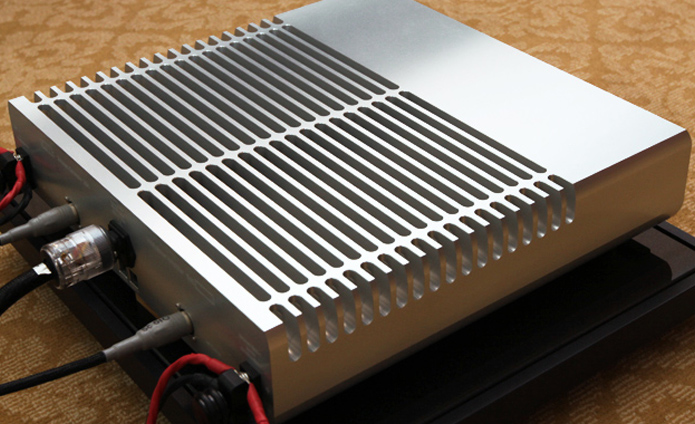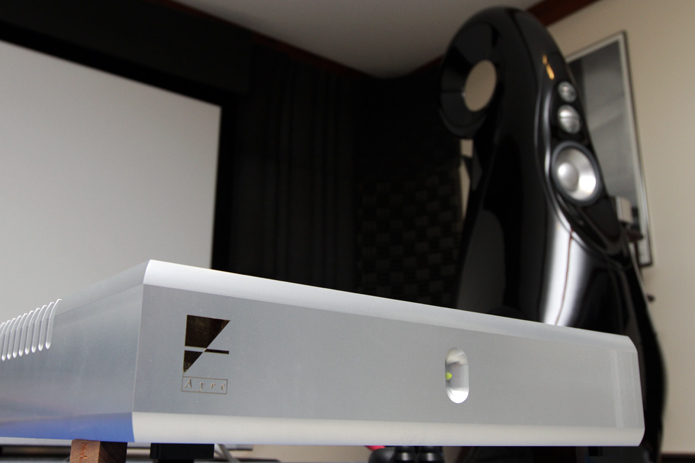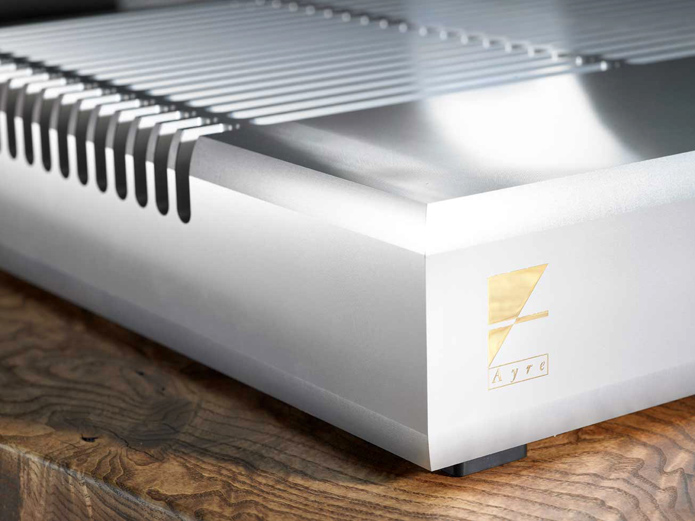Note: Measurements performed by BHK Labs can be found through this link.

 Solid-state amplifiers are often the least inspiring components to review. Not all solid-state amps sound the same, as some would have you believe, but many sound quite similar to each other, and few have a sound that really lights my fire. It’s probably because of this “sameness” that so many still swear by tube amplification, not to mention the fun that can be had by mixing and matching different models of the same tube type, aka tube rolling. As for controls, most power amplifiers have a power button, maybe a standby switch, and a little light somewhere that tells you it’s on. Not that much to talk about. Finally, high-powered amps are usually big, which wouldn’t be so bad if so many of them -- even some really expensive ones -- weren’t also chunky, clunky eyesores. So ask me to a review a solid-state power amplifier, and my first response is normally, “Is there anything else in the queue?”
Solid-state amplifiers are often the least inspiring components to review. Not all solid-state amps sound the same, as some would have you believe, but many sound quite similar to each other, and few have a sound that really lights my fire. It’s probably because of this “sameness” that so many still swear by tube amplification, not to mention the fun that can be had by mixing and matching different models of the same tube type, aka tube rolling. As for controls, most power amplifiers have a power button, maybe a standby switch, and a little light somewhere that tells you it’s on. Not that much to talk about. Finally, high-powered amps are usually big, which wouldn’t be so bad if so many of them -- even some really expensive ones -- weren’t also chunky, clunky eyesores. So ask me to a review a solid-state power amplifier, and my first response is normally, “Is there anything else in the queue?”
This time, there was no hesitation. Enter Ayre Acoustics’ VX-R stereo power amplifier ($14,950 USD).
Description
Ayre Acoustics’ R-series line -- to which belong the KX-R preamplifier, the MX-R monoblock, and now the VX-R -- embodies the ultimate design ideals of Charles Hansen, founder, president, and chief designer. I’ve talked to Hansen several times over the years, and he’s as outspoken about audio as he is knowledgeable. He’s self-described as “pretty out there,” meaning he’s willing to entertain the most outlandish idea. But he’s no quack -- look at the measurements of any Ayre product, such as the ones we took of the VX-R, and you’ll see that he’s a rock-solid engineer.
If you’re familiar with Ayre’s top-of-the-line amplifier, the MX-R monoblock ($9750 each), then you’re also familiar with the VX-R. The VX-R is basically two scaled-down MX-Rs in one case -- scaled down in terms of size and power output, but not in build quality, general appearance, or sound. I didn’t crack open the bottom of the VX-R to get inside, but Ayre says that if you do, what you’ll see will be, basically, two mono amps.
A single MX-R measures 11"W x 3.75"H x 18.75"D and weighs 52 pounds. Double all that for a pair. The VX-R is 17.75"W x 3.75"H x 18.75"D and 78 pounds. Ayre says the MX-R can deliver 300W into 8 ohms or 600W into 4 ohms. The VX-R delivers 200Wpc into 8 ohms or 400Wpc into 4 ohms. Ayre rates the amps’ frequency response from DC to 250kHz.
The MX-R and VX-R share the same basic circuit and, like all Hansen designs, use no feedback. Feedback, whether global or local, is used in most amplifiers to lower distortion and output impedance and increase bandwidth, among other things. It involves feeding a portion of the output signal back into the input to correct it. Global feedback can be thought of as a correction loop around the entire amplifier circuit; local feedback refers to a correction loop(s) within a stage or stages of an amp. Whichever kind of feedback you use, it will introduce timing errors -- a form of distortion. How audible these errors might be is the subject of endless debates among amplifier designers, but Hansen’s view, like that of many designers, is that no feedback is better than some. The VX-R’s circuit is designed to be inherently linear from input to output, and to thus, theoretically, require no feedback in the first place -- which is not nearly as easy to do as that simple statement implies.
Also like the MX-R, the VX-R is fully balanced, and uses ON Semiconductor Corp.’s ThermalTrak transistors in its output stage. A lot of information can be found online about these devices; in a nutshell, Hansen chose them for their superior biasing and thermal-regulation characteristics. There’s also Ayre’s EquiLock circuitry, “a method we employ that allows us to get a linear response (voltage) across all of our active gain transistors.” A special circuit-board material was selected for the R series that Ayre says is “incredibly fast in terms of signal speed across the architecture.” The VX-R also includes a built-in Ayre Conditioner power-line filter. I saw no reason to plug the review sample into anything but the wall.

Then there’s the exceptional casework. The VX-R, like the MX-R and KX-R, has a case carved from a solid block of aluminum and finished to perfection. I need to emphasize that: the entire case begins as a single solid block of metal -- heatsinks, internal compartments, connector holes, etc., are all created by cutting away precious chunks of aluminum. This is probably the most expensive way to make an amplifier -- it’s difficult to do, and much of the metal goes to waste -- but the VX-R has been designed as a state-of-the-art model. When you see the result, you’ll probably agree that it’s worth the price, particularly when you factor in its svelte appearance. I’ve seen the top-dog amps from Krell, Boulder, Constellation, Soulution, etc., all with their overbuilt bodies and that clunky, chunky look I abhor; in my opinion, they look like crap compared to the VX-R, whose size, proportions, and looks all seem just right. The VX-R’s low profile, in particular, was a welcome sight in my listening room, and its length and width are ideal. The finish of the review sample was superb, making the VX-R, hands down, the best-looking power amp I’ve ever seen. I don’t know whether, in my 16 years of reviewing, I’ve ever described a solid-state amp as sexy, but this one is -- and it was a component that, for once, I was proud to display in my room. It’s available in black or silver, with the Ayre logo glimmering at the front left.
The VX-R doesn’t have many features, which is the way it usually is with power amps. On the rear panel are two Cardas speaker-wire binding posts (I love these things for how well they clamp down on a set of spade-terminated cables), an IEC-compatible power-cord inlet, and one AyreLink port each for input and output (they can actually be used interchangeably), for communication between and automated operation of other Ayre components. The VX-R has only one set of inputs, and they’re balanced (XLR), which means that balanced connection is preferred. If you have only a single-ended (RCA) preamp or other source, adapters are available.
One thing that’s fancier than it first appears is the single LED on the front, which also serves as a power button. Though the VX-R has no Standby switch, as do many amps, it goes into Standby mode when you first plug it in, at which point the LED glows green. Push it and the amp turns on and the LED glows blue. If you want to change the LED’s intensity, unplug the VX-R’s power cord, then plug it back in while pressing the LED -- the VX-R will enter what Ayre calls Configuration Mode for ten seconds, and the LED will flash violet. While in this mode, you can press the LED once, twice, or thrice, for low, medium, or high brightness.
You should hope never to see the LED’s other colors. Orange means that the amplifier is too hot -- when that happens, the VX-R automatically shuts itself down. When it’s cooled down, it goes into Standby mode and the LED glows green. Red means there’s a DC offset problem, and flashing red means that a fuse has blown. Finally, violet means that the line voltage is too low. As with “Code Orange,” the amplifier shuts itself down, then returns to Standby mode; the LED glows green when the line voltage has come back up.
Obviously, the VX-R has some smarts built in to protect itself -- Charles Hansen believes that a well-designed amplifier shouldn’t be a fire hazard, or something that will blow up your speakers, and his protection system seems to work well. I never had any problems with the VX-R, but before I received it, the review sample had been sent to Bascom King to be measured. In the process of taking his measurements, Bascom decided to try driving the VX-R to a level of 10% distortion -- an obscene amount of distortion for any solid-state amplifier to produce, and not something we typically subject one to. But given the impressive figures Bascom was seeing, I suspect he thought it would be interesting to at least try to see how this amplifier would behave when stressed to the utmost. (I won’t repeat here what Hansen said when we told him that his amp was being torture-tested -- it wasn’t polite.) The VX-R would have none of it -- it fought Bascom’s instruments tooth and nail, shutting itself down instead of risking self-immolation. Ayre checked out the VX-R after this test and declared it 100% fit for review by me -- there was no damage; the protection circuitry had acted exactly as it should.
Performance
The VX-R is rated to output 200Wpc into 8 ohms. When Bascom King measured it, it more than met that spec. I listened to it for months with a few different loudspeakers, and it sounded every bit as powerful as that big number of watts indicates. It drove every speaker I connected to it with ease, always sounding effortless, and always with power to spare. Not once did the VX-R sound strained.
Probably the most demanding speaker I used with the VX-R was Revel’s Ultima Salon2, which presents a 4-ohm load for everything under 500Hz or so. That didn’t faze the VX-R, no matter how loudly I played it. I’ve been told that the Salon2 performs better with an amp that can deliver hundreds and hundreds of watts, but I’ve never heard the need for that. The VX-R was fine -- and I have a really big room.

The most interesting speaker I drove with the VX-R was Vivid Audio’s extraordinary Giya G2. A speaker of moderate sensitivity (about 88dB), the Giya G2 can play astonishingly loud when backed by a stout amplifier. I can get out of hand, playing the most raucous rock imaginable at extreme sound-pressure levels, but neither the VX-R nor the Vivids lost composure when I did -- which, given how well these components worked together, was often.
That’s all I need to say about power output -- most people expect a modern solid-state amp that costs nearly $15,000 to deliver the juice it’s supposed to across the audioband and not have to strain when the going gets tough. If it can’t, then it has no reason to be. I believe that anyone who buys an amp at this price is looking for something that sounds superior, if not unique. The upper reaches of hi-fi should be about more than just high power or a pretty case.
That said, the VX-R did sound better overall than any amp I’ve heard, and uniquely so. What first struck me about its sound was an uncanny smoothness and purity, with a hint of richness and vibrancy -- just a bit, not overblown -- that typical class-AB solid-state amps often lack. It was akin to the sound I hear from a topflight solid-state amp working in pure class-A, or a great tube amp, but without all the problems that accompany such designs. (Pure class-A amps are tremendously inefficient and generate lots of heat, while tube amps, even the very best, aren’t as reliable as their solid-state counterparts.) Instead, the VX-R retained the sonic qualities that class-AB solid-state is known for -- high power, wide bandwidth, extreme neutrality, ample headroom -- along with a cleanness and purity that made it enthralling to listen to.
The VX-R was also dead quiet -- the subtlest details emerged from nothingness, which meant that detail and resolution were sky-high and transparency was first-rate. But despite all that detail, the VX-R never sounded clinical, analytical, or cold, the way some hyperrevealing solid-state amps can. The delicate balance it maintained was that of a hyperrevealing amplifier that was an absolute joy to use to listen to any kind of music at any volume level. And I’m not talking just loud -- the VX-R’s low self-noise allowed the Giya G2s, which themselves are very revealing, to sound quite alive even at SPLs just above a whisper. Because of all this, the VX-R was my go-to amp for many months. I probably held on to it longer than Ayre would have preferred. I couldn’t help it -- I wanted to play everything I could through it, and I did.
My music collection is varied, but I favor recordings in which the focus is on the voice. Case in point: The recordings of fado singer Mariza sound exceedingly natural, and her voice is always placed front and center. Played through the VX-R, “Há Uma Música do Povo,” from her Transparente (16/44.1 FLAC, Times Square), was notable for the great purity of her voice; for its excellent separation from the instruments played by her band, who were placed distinctly behind her on the stage; and for the expansiveness of the soundstage, which stretched way out to the sides and past the front wall of my room. The quicker-paced “Recusa” sounded so liquid that the speaker end of the room seemed to get wet, yet the VX-R never got so syrupy that it started to sound slow -- its levels of detail and transparency were, again, astonishingly high. Often, amplifiers get one aspect of performance right at the expense of another; in my room, the VX-R got every aspect of performance right, and left me nothing to criticize.
Fellow writer S. Andrea Sundaram turned me on to Ferry Tales, by tuba player Øystein Baadsvik with pianist Erlend Skomsvoll and the Trondheim Soloists (24/48 FLAC, BIS/eClassical), and I’m glad he did. This collection of Scandinavian compositions and a few standards interestingly arranged for tuba, piano, and orchestra is well recorded and very natural sounding, with exceptional dynamic range. “Prince Igor: Fantasy on a Theme by Borodin” is intensely involving, and thrilling to listen to for all the detail it contains. Nothing was lost through the VX-R -- the dynamic contrasts were thoroughly preserved, and no nuance went missing. But that’s just one cut -- the results were the same with everything else I played through the VX-R. It got the macro and micro elements of every recording just right -- a real powerhouse capable of the most delicate finesse.
If you reread the preceding paragraphs and take note of all the qualities I mentioned, you’ll realize that the VX-R sounded nearly flawless. In fact, you could call it a chameleon -- it could change from one kind of music to another and play it back at any volume level with ease. When I put on a wonderful, minimalist track such as Rebecca Pidgeon’s cover of “Spanish Harlem,” from The World’s Greatest Audiophile Vocal Recordings (16/44.1 FLAC, Chesky), which features only a handful of musicians, I was astonished at how pure, smooth, and open it sounded, and how much detail that recording contains. More complex recordings retained the same sort of purity and smoothness, with the subtle details just as easy to pick out. I was more than impressed with how easy it was to discern individual voices and instruments in complex choral and orchestral works -- in this regard, the VX-R was as good as or better than any other amplifier I’ve heard.
Then there’s something that not all audiophile components, even amplifiers, do well: totally rock out. Some audiophiles thumb their noses at the notion of using rock recordings, particularly of hard rock or metal, as evaluation tools, but I think they’re wrong. The fact is that some amps and/or speakers cry uncle, or simply sound dreadful, when asked to reproduce this kind of music -- music I like to listen to from time to time, sometimes at headbanging levels. Every rock track I played through the VX-R, from Guns N’ Roses to Nirvana to April Wine, was reproduced with the kind of conviction and immediacy that this music needs. And when the Ayre drove the Vivid Giya G2s, speakers that are unbelievably good at playing loudly and cleanly, I heard the best-sounding hard rock I’d ever heard from a high-end hi-fi system.
The VX-R played all kinds of music perfectly and effortlessly -- there seemed to be nothing it couldn’t do. Does that mean it’s the perfect amplifier? For most, including myself, I suspect that the answer is yes. On the other hand, those with very insensitive speakers and/or who want to play music extraordinarily loud (and whose speakers can take a commensurate amount of juice) might need even more power. But for those folks, even Ayre’s MX-Rs likely won’t be powerful enough; they’ll have to buy something that delivers half a kilowatt of power, if not more.
I can’t imagine anyone quibbling with the VX-R’s smooth midrange, silky highs, awesome detail, outstanding transparency, dead quiet, and trouble-free operation -- but some might take issue with its bass. The Ayre’s bass was extremely deep and powerful with the full-range Vivid Giya G2s and Revel Ultima Salon2s, but it wasn’t as tight-fisted as that of, say, my Bryston 4B SST2, which has a little more of a typical solid-state sound: a touch leaner, and certainly not as silky, rich, and full throughout the audioband, but with bass impact akin to a steel pole being driven through the center of the earth. Still, the VX-R presented its bass deeply, with as much richness and bloom as it had force.
After months of listening to the VX-R, that’s the only caveat I can come up with. In fact, for some, it won’t be a problem at all -- they’ll enjoy the VX-R’s richer bottom end. Those who want brute-force power with heart-stopping impact, but not the other sonic characteristics I’ve described, might look elsewhere for a high-powered amp. But I wouldn’t trade all that the VX-R does right for anything else another amp might offer -- its sound was as close to perfect as that of any power amp I’ve heard.
Conclusions
When the price of a single audio component approaches or exceeds the price of a car, some people raise their eyebrows. I’m one of those people, and from time to time I’ve mocked the extremely high prices asked for certain products. It’s gotten me a reputation for being a cheapskate, and in some ways I guess I am. I’m not against costly gear per se; I just don’t like to see high-priced components that aren’t very good, or any better than products costing a fraction as much. If something costs many thousands of dollars, I want it to prove to me that it could be worth its price. That’s part of being a critic.

Ayre Acoustics sent me their newest amp already knowing my thoughts on such things, but the VX-R more than proved its worth. In fact, looking at the marketplace, I believe that the VX-R might even be a bit underpriced for what it offers. (Some cheapskate, eh?) Solid-state amps often bore me, but I was thrilled by the VX-R’s build quality, appearance, and sound -- a combination I haven’t seen or heard executed so well in any power amplifier at a lower price. A price of $14,950 isn’t insignificant -- but after looking at, living with, and listening to the VX-R, I find it easy to justify.
The Ayre Acoustics VX-R is that rare component: a luxury audio component in every way, a reference-caliber performer, and a very good value at its high price. It’s not only one of the best products of any kind I’ve ever reviewed, it’s the very best power amplifier I’ve ever heard. It’s the first solid-state power amplifier to come along in a long time that not only inspired me, but thrilled me to the point that I didn’t want to see it go. When an amplifier comes along that bowls me over visually and sonically and gets me excited, then it has to be special.
. . . Doug Schneider
das@soundstagenetwork.com
Associated Equipment
- Speakers -- Vivid Audio Giya G2, Revel Ultima Salon2, Mirage OM Design OMD-28
- Amplifiers -- Bryston 4B SST2 (stereo), Blue Circle Audio BC204 (stereo), Simaudio Moon 400M (mono)
- Preamplifiers -- Eximus DP1, Simaudio Moon 350P, JE Audio VL10.1
- Digital sources -- Eximus DP1, Simaudio Moon Evolution 650D DAC-transport, Hegel HD10 DAC, Bryston BDP-1 digital player, Sony Vaio laptop
- Digital interconnects -- AudioQuest Coffee USB, DH Labs D-110 AES/EBU
- Analog interconnects -- Nirvana S-L, Nordost Valhalla
- Speaker cables -- Nirvana S-L
Ayre Acoustics VX-R Stereo Amplifier
Price: $14,950 USD.
Warranty: Five years parts and labor.
Ayre Acoustics
2300-B Central Avenue
Boulder, CO 80301
Phone: (303) 442-7300
Fax: (303) 442-7301
E-mail: info@ayre.com
Website: www.ayre.com






















